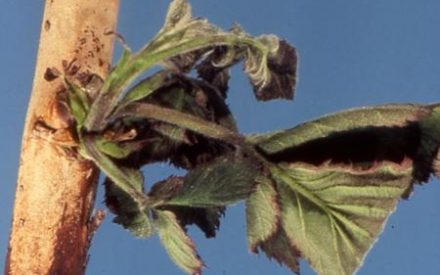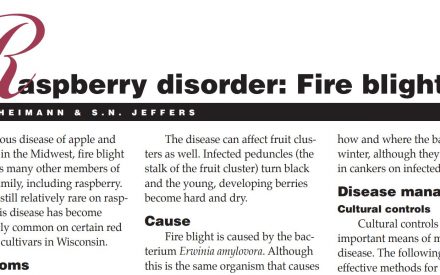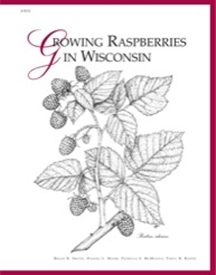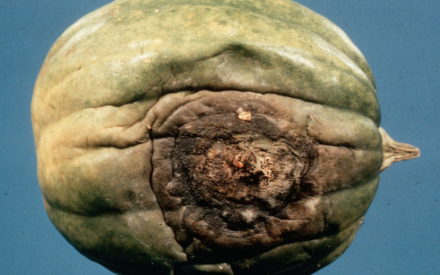
What is raspberry anthracnose?
Raspberry anthracnose is a common disease that causes significant reductions of yield and fruit quality on raspberries in the United States. Black and purple raspberries (oftentimes misidentified as blackberries) are particularly susceptible to anthracnose, while red raspberries are less susceptible to the disease. True blackberries are also occasionally affected by anthracnose.
What does raspberry anthracnose look like?
Anthracnose can affect any part of a raspberry plant; however, canes are most commonly affected. Watch for scattered, purple, roundish spots (up to ⅜ inch in diameter) that are characteristic of the disease. Over time, the spots develop ash-colored, sunken centers and raised purple margins. When anthracnose is severe and develops early in the growing season, these sunken spots can merge and girdle raspberry canes, resulting in cane death. When anthracnose develops later in the season spots may not develop sunken centers, but will overlap and merge. If a large enough portion of a cane is affected, the bark may split. This symptom is called “gray bark”. Canes severely affected by anthracnose are more prone to winter injury. On leaves, anthracnose symptoms typically appear in early to mid-summer as irregularly-shaped, yellow spots that are approximately 1/16 inch in diameter. These spots enlarge and develop gray centers with reddish-purple borders. Over time, the gray centers may fall out, giving the spots a “shot-hole” effect.
Where does raspberry anthracnose come from?
Anthracnose is caused by the fungus Elsinoe necator. The fungus can be introduced into a raspberry patch on infected plants or by spores that are blown from other raspberry patches or from wild raspberry relatives (such as brambles). Once established in a raspberry patch, E. necator can overwinter on diseased raspberry canes. In the spring, spores of the fungus spread to new canes (which are more susceptible to infection due to their lack of a hard bark) and leaves by wind, rain splash, and insects. Infections are more likely to occur during long periods of wet weather. Additional spores produced as a result of these early season infections can lead to additional infections late in the summer (e.g., in late August and September).
How do I save a plant with raspberry anthracnose?
Anthracnose is difficult to manage once symptoms have developed. Pruning symptomatic canes as they appear may provide some benefit, but only when disease levels are relatively low. Prune four to six inches below where symptoms have appeared and decontaminate pruning tools between cuts by treating them for at least 30 seconds with 10% bleach or preferably (because of its less corrosive properties) 70% alcohol. Rubbing alcohol and many spray disinfectants typically contain approximately 70% alcohol and are easy to use. Canes can be burned (where allowed by local ordinance) or buried. Fungicides are not effective for controlling anthracnose once infections have occurred and should be only be used preventatively (see below).
How do I avoid problems with raspberry anthracnose in the future?
When establishing your raspberry patch, choose a sunny, open area with a well-drained soil. Remove plants related to raspberries (e.g., brambles) from the vicinity of your patch as these plants can potentially be a source of the anthracnose fungus. Purchase disease-free raspberry plants from a reputable nursery or other raspberry supplier, and space these plants in rows that are 12 to 18 inches apart to promote good air flow, and rapid drying of plants. Fertilize your raspberries appropriately (see Growing Raspberries in Wisconsin), but do not overfertilize with nitrogen. Heavy nitrogen fertilization will stimulate excessive growth of tender canes that are more susceptible to infection by the anthracnose fungus. When watering, do not use a sprinkler; instead use a soaker or drip hose that applies water to the soil rather than to onto leaves and canes. Keep weeds under control so that they do not block air movement.
Once your raspberry patch is established, prune raspberries routinely (again, see Growing Raspberries in Wisconsin) to remove diseased and winter-injured canes as well as to promote better air flow. If anthracnose has been a chronic problem in your raspberry patch, consider using a preventative fungicide treatment for control. Use a single application of liquid lime sulfur (1⅓ cups per gallon of water) when leaf buds show ¼ to ½ inch of green tissue. Be sure to read and follow all label instructions to ensure that you use the fungicide in the safest and most effective manner possible.
For more information on raspberry anthracnose:
Contact the University of Wisconsin Plant Disease Diagnostics Clinic (PDDC) at (608) 262-2863 or pddc@wisc.edu.
Authors: Chen Zhang*, UW-Madison Plant Pathology
Last Revised: 03/01/2024
D-number: D0091
*Completed as partial fulfillment of the requirements for Plant Pathology 558 at the University of Wisconsin Madison.
References to pesticide products in this publication are for your convenience and are not an endorsement or criticism of one product over similar products. You are responsible for using pesticides according to the manufacturer’s current label directions. Follow directions exactly to protect the environment and people from pesticide exposure. Failure to do so violates the law.
Thanks to Diana Alfuth, Erica Arcibal, Ken Frost, Kristin Krokowski, Patricia McManus, Anna Seidl, and Pauline Zhu for reviewing this document.
A complete inventory of UW Plant Disease Facts is available at the University of Wisconsin-Madison Plant Disease Diagnostics Clinic website: https://pddc.wisc.edu.
Send a Plant Sample for Analysis
Be cautious when self-diagnosing plant health issues. Very few diseases can accurately be diagnosed by eye.
Contact the UW Plant Disease Diagnostics Clinic (PDDC), and for a small fee, clinic staff can examine a plant, determine the cause of the disease/disorder, and provide advice on how to control or prevent the issue.
Download Article





 Cane Blight
Cane Blight Raspberry Disorder: Fire Blight
Raspberry Disorder: Fire Blight Growing Raspberries in Wisconsin
Growing Raspberries in Wisconsin Vine Crops Disorder: Anthracnose
Vine Crops Disorder: Anthracnose


